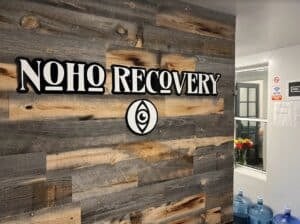Ecstasy Withdrawal and Detox
What Is Ecstasy Withdrawal?
Ecstasy, also known as MDMA or molly, is a synthetic psychoactive drug that produces a euphoric high in the user. Ecstasy is extremely psychologically addictive. Those addicted to ecstasy will experience withdrawal when they quit using the drug. Withdrawal happens because the user’s brain becomes dependent on ecstasy to function.
Taking ecstasy increases the activity of neurotransmitters—specifically those that influence feelings of happiness and love—in the brain. This causes the euphoric high and positive emotions associated with using ecstasy. However, this increase in activity also quickly depletes the brain’s supply of the chemicals needed to feel this way.
Online Addiction Counseling
Get professional help from an online addiction and mental health counselor from BetterHelp.
- Access to Therapy 24/7
- Easy Online Scheduling
- 20,000+ Licensed Therapists
Paid Advertising. We may receive advertising fees if you follow links to the BetterHelp site.
After prolonged use, the user’s brain can become dependent on ecstasy to function and experience these positive feelings. When someone quits taking the drug, they’ll go through withdrawal as their brain tries to relearn how to operate properly without it. During withdrawal, users typically experience the opposite of what they felt while high, like depression and anxiety. They’ll also intensely crave the drug.
The symptoms of ecstasy withdrawal tend to be primarily psychological, but some users experience physical effects as well. The symptoms and duration of withdrawal vary by person. Some of the things that affect the withdrawal process include:
- Tolerance
- The frequency and duration of drug use
- Metabolism and overall health
- Age
- Gender
- Genetics
A user who has multiple addictions may also have a more intense and complicated withdrawal, and a user who has co-occurring mental health disorders may also experience additional challenges.
Symptoms of Withdrawal
Withdrawal from ecstasy can produce serious psychological symptoms and some users may experience physical discomfort. However, the physical effects are typically mild and not life-threatening. Ecstasy withdrawal symptoms may include:
- Depression
- Confusion
- Anxiety
- Cravings
- Agitation
- Paranoia
- Insomnia
- Fatigue
- Difficulty concentrating
- Loss of appetite
- Memory problems
- Changes in self-perception
Ecstasy is often cut with other drugs, such as heroin, ketamine, amphetamines and other illicit drugs. In many cases, ecstasy is also taken alongside other drugs, such as marijuana, cocaine or LSD. Because it’s hard to know what’s in a pill of ecstasy and so many users tend to combine it with other drugs, withdrawal symptoms are often different for each person.
Although ecstasy withdrawal does not typically produce dangerous physical symptoms, the powerful psychological withdrawal can lead many users to relapse.
Relapse during the withdrawal process is especially dangerous because the user’s tolerance has decreased. If they jump back into using the same amount of ecstasy, they’re at an increased risk of overdose—which can be fatal.
Managing the symptoms of withdrawal from ecstasy—especially the feelings of depression, which are often severe—can be difficult for a person to do on their own. It is recommended that users complete the withdrawal process in a medical detox facility or an inpatient rehab.
Looking for a place to start?
Join the thousands of people that have called a treatment provider for rehab information.
Free and confidential
Available 24/7
Access to professional treatment
Like the symptoms of ecstasy withdrawal, the duration of the process is different for everyone. Symptoms usually peak within a few days of quitting the drug and last about a week. Severe psychological symptoms, like depression and cravings, may persist for several weeks to several months.
Ecstasy Withdrawal Timeline
| Days 1-3 | Withdrawal symptoms begin within a few days of quitting ecstasy. Anxiety, irritability, insomnia, an inability to concentrate, paranoia and depression may present quickly and intensely. Users may also lose their appetite and feel physically and mentally tired. |
|---|---|
| Days 4-10 | Most withdrawal symptoms last about a week and will lessen in severity toward the end of that time. Depression, cravings and problems with sleeping, concentration and memory may persist. |
| Days 11+ | Over the next few weeks, depression can be severe as the user’s brain chemistry continues to readjust. The user may still struggle with cravings, insomnia, and concentration and memory problems. These symptoms will eventually fade, but it can take weeks or even months for some users to be completely free of the effects of withdrawal. |
Featured Centers Offering Treatment for Ecstasy Addiction


Ecstasy Detox
Ecstasy withdrawal symptoms can be quite stressful. Without the proper care, a former user runs the risk of relapsing during the withdrawal process.
When quitting ecstasy, former users are encouraged to seek professional help in a medical detox program.
Medical detox is offered in many inpatient and outpatient treatment centers. During medically assisted detox, physicians monitor the ecstasy user as they go through withdrawal. The doctor may prescribe medications, such as antidepressants, to help with some of the psychological symptoms of withdrawal.
Given that ecstasy is often cut with other drugs, the withdrawal symptoms are unpredictable. In medical detox, doctors monitor the user’s progress and can intervene if any symptoms become too severe. Medical detox is the safest way for ecstasy users to begin their path to sobriety.
Check if my insurance covers rehab
Addiction Center is not affiliated with any insurance.
Treatment for Ecstasy Addiction
A drug treatment center provides a safe, controlled environment in which ecstasy users can work toward recovery. These programs create individualized treatment plans based on each patient’s specific needs. Outpatient treatment is also an option for those who do not have the time or resources to attend inpatient rehab. Contact a treatment provider today for help finding an ecstasy addiction treatment program.
Published:
Author
Jeffrey Juergens

-
Jeffrey Juergens earned his Bachelor’s and Juris Doctor from the University of Florida. Jeffrey’s desire to help others led him to focus on economic and social development and policy making. After graduation, he decided to pursue his passion of writing and editing. Jeffrey’s mission is to educate and inform the public on addiction issues and help those in need of treatment find the best option for them.
- More from Jeffrey Juergens
Reviewed by Certified Addiction Professional:
Theresa Parisi

Theresa Parisi is a Certified Addiction Professional (CAP), Certified Behavioral Health Case Manager (CBHCM), and International Certified Alcohol and Drug Counselor (ICADC) with over 12 years of experience in the addiction treatment field.
- More from Theresa Parisi
Sources


Recovery Starts Today
Call Now For Addiction Support



Newport Academy – Teen Rehab Center
Port Townsend , WA


Sequoia Detox Centers
Spokane Valley , WA

Bayside Marin Treatment Center
San Rafael , CA

Newport Institute for Young Adults
Sunol , CA

Moonlight Mountain Recovery
Pocatello , ID


Tarzana Recovery Center – TRC
Tarzana , CA


Hollywood Hills Recovery
Los Angelos , CA



Gratitude Lodge Drug & Alcohol Rehab
Long Beach , CA

Asana Recovery – Outpatient Treatment Center
Fountain Valley , CA